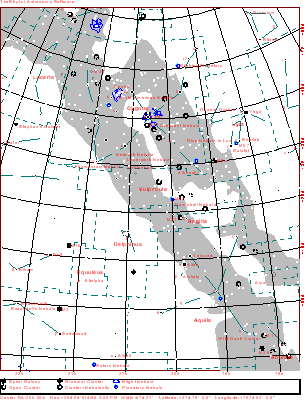
| Home | Deepsky Atlas | TheAstronews | Links | Solar System | ||||||

Hawaiian Astronomical SocietyConstellations: Vulpecula -- A Fox nabs a Goose |
||||||||||
Fuchs, Du hast die Gans gestohlen, Fox, you stole the goose, Gib sie wieder her. Give her back. Sonst wird Dich der Jäger holen Or the hunter will get you mit dem Schießgewehr. With his gun.
When Hevelius invented this constellation in 1690, he named it Vulpecula cum Anser (Fox with Goose). Now we call this faint group of stars in the Milky Way south of Cygnus Vulpecula.

Click the map for a 916x1200 version of the above. Click here for a map better suited for use in the field.

This a more detailed view of the constellation. The map displays stars to magnitude 10, and deepsky objects to magnitude 12. Click here for a map better suited for use in the field.

Click here for a map better suited for use in the field.
 66k JPEG. NGC6940 (Best 111) is very bright (mag. 6.3), very large (31'), very rich (100 stars, mag. 9.3 and fainter), condensed open cluster found 3.5° south-west of 52 Cygni portion of the Veil Nebula. Dreyer mentions a fairly "large" star in the field. It is somewhat orange colored. Photograph by Naoyuki Kurita, taken with a Takahashi Epsilon 160 with Fujicolor Super G Ace 400. 66k JPEG. NGC6940 (Best 111) is very bright (mag. 6.3), very large (31'), very rich (100 stars, mag. 9.3 and fainter), condensed open cluster found 3.5° south-west of 52 Cygni portion of the Veil Nebula. Dreyer mentions a fairly "large" star in the field. It is somewhat orange colored. Photograph by Naoyuki Kurita, taken with a Takahashi Epsilon 160 with Fujicolor Super G Ace 400.
|
 77k JPEG. NGC6885 (Caldwell 37) is a cluster of 30 stars mag. 6 and fainter, and embedded in a rich field. Described as very bright (mag. 5.7), very large (7'), and somewhat irregular in shape, it is hard to pick out of the Milky Way. The photograph shows both 6885 and its much larger and fainter companion, 6882. The bright star at the top of the Digital Sky Survey photograph is 19 Vulpeculae. the second brightest star (bottom, center) is 20 Vulpeculae. 6885 is clustered tightly around 20 Vulpeculae, partially hidden in its glare. 6882 lies to the right (west) of a line between 19 and 20. It lies 3/4th of the way toward 20. 77k JPEG. NGC6885 (Caldwell 37) is a cluster of 30 stars mag. 6 and fainter, and embedded in a rich field. Described as very bright (mag. 5.7), very large (7'), and somewhat irregular in shape, it is hard to pick out of the Milky Way. The photograph shows both 6885 and its much larger and fainter companion, 6882. The bright star at the top of the Digital Sky Survey photograph is 19 Vulpeculae. the second brightest star (bottom, center) is 20 Vulpeculae. 6885 is clustered tightly around 20 Vulpeculae, partially hidden in its glare. 6882 lies to the right (west) of a line between 19 and 20. It lies 3/4th of the way toward 20.
|
Perhaps the premier planetary nebula in the sky, M27 (NGC6853) is located 3.2° north of Gamma Sagitae (the point of the arrow). Dreyer describes it as very bright (mag. 8.1), very large (15'), with brighter irregular nebulosity. The "dumbbell" shape is there with a little imagination.
| Map | Printable Map | More info. |
 108k JPEG. Photographer's notes: M27 taken at f6.3 with LX 200-10" and ST7. Self guided. Minimal processing with SKYPRO and Photo Styler. A satellite is crossing the nebula. Exposure time is 14 minutes. From Kissimmee State Park, FL. José Torres. 108k JPEG. Photographer's notes: M27 taken at f6.3 with LX 200-10" and ST7. Self guided. Minimal processing with SKYPRO and Photo Styler. A satellite is crossing the nebula. Exposure time is 14 minutes. From Kissimmee State Park, FL. José Torres.
|
 102k JPEG. Christian Buil image of M27 using a 160mm Takahasi camera. Shot through RGB filters. 102k JPEG. Christian Buil image of M27 using a 160mm Takahasi camera. Shot through RGB filters.
|
 41k JPEG 41k JPEG |
 84k JPEG 84k JPEG |
The open cluster NGC6802 sits on the eastern edge of Collinder 399. It is a mag. 8.8 open cluster with 50 mag. 13.8 stars and fainter visible in an 8". A large enough scope will see stars down to mag. 18 in a 3.2' oval. A 4" telescope will show a hazy bar.
The image on the left is a drawing from Larry's Deepsky Sketches. Also here, here, and here. The image on the right is a mosaic from the Digital Sky Survey.
|
If you have any questions about the Hawaiian Astronomical Society
please
(link requires javascript).